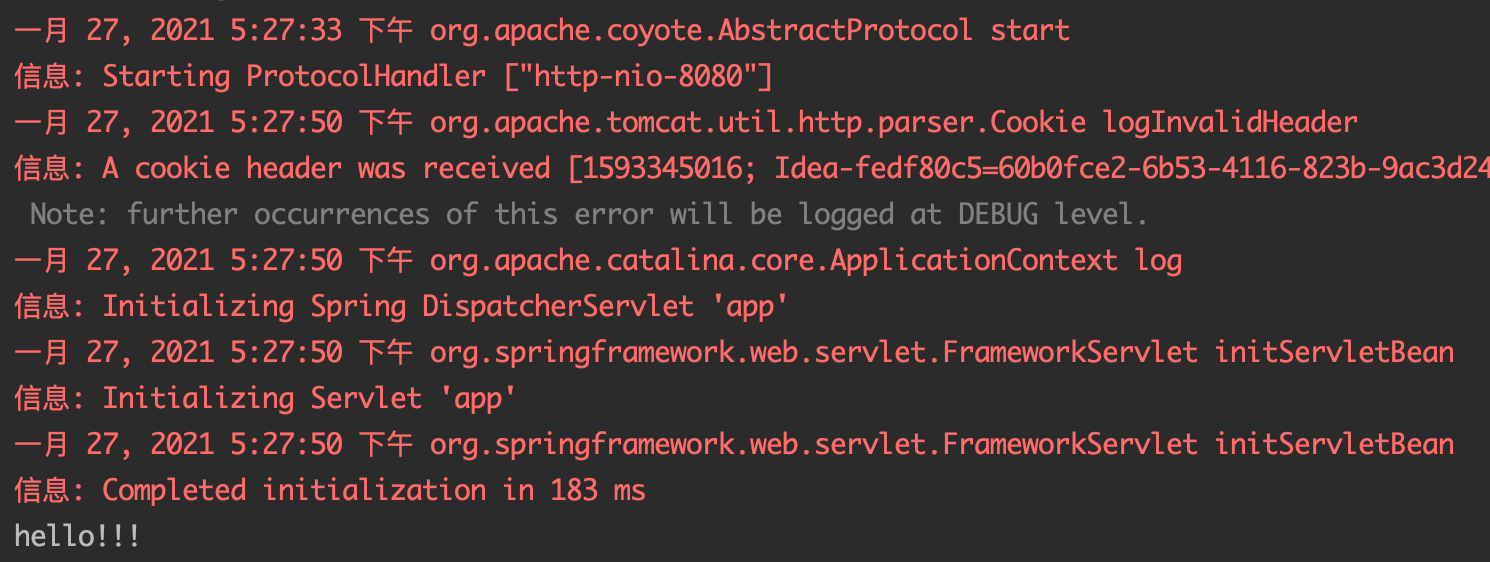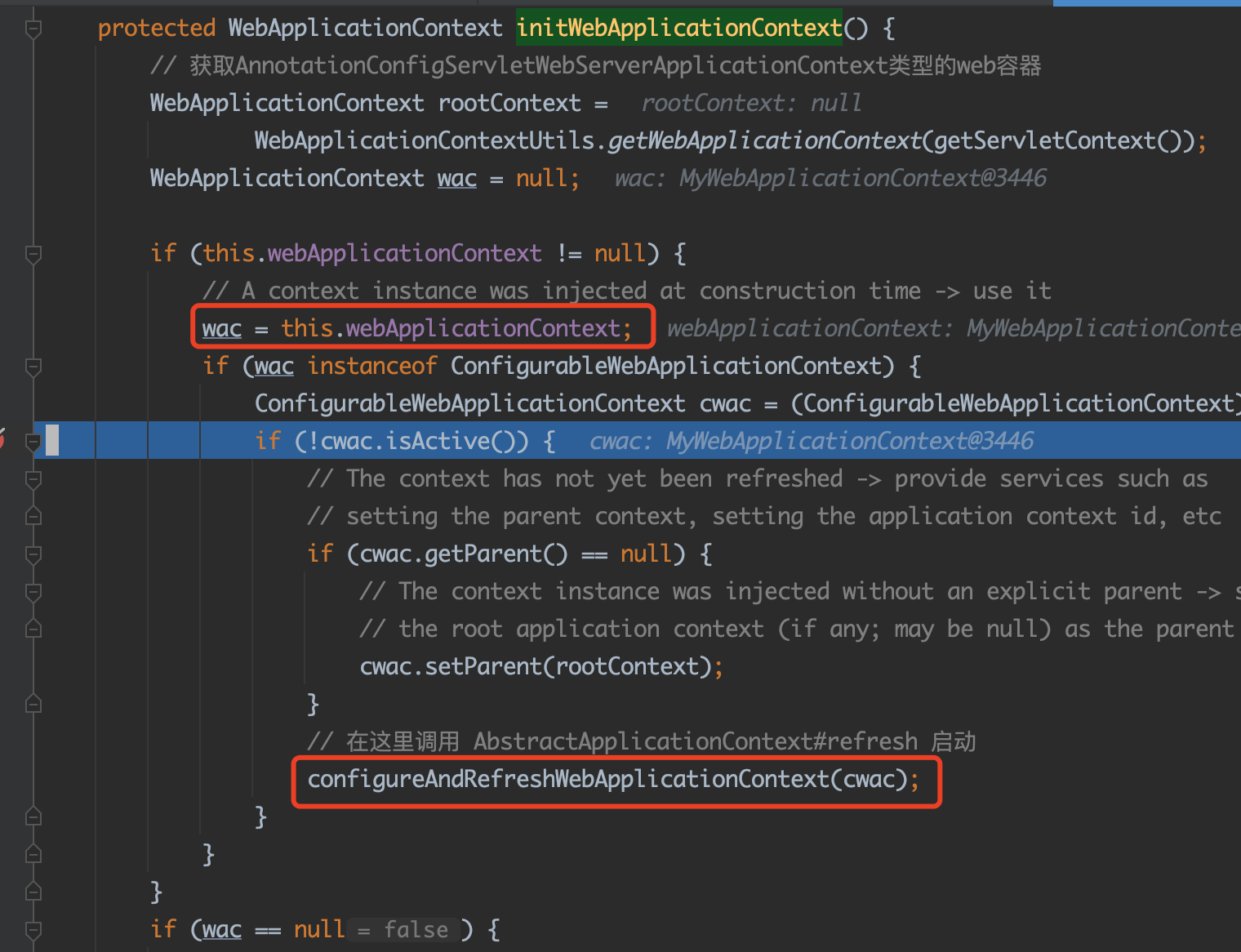''在 spring mvc 之 springmvc demo 与 @EnableWebMvc 注解一文中,我们提供了一个示例 demo,该 demo 会先启动 servlet 容器,然后通过 servlet3.0 规范将 DispatcherServlet 注册到 servlet 容器中,然后在 DispatcherServlet#init 方法中启动 spring 容器,整个流程就像这样:
这没什么问题,能正常启动也运行良好,只不过我们在 spring 容器中无法获取 DispatcherServlet,像这样:
@Component
public class Test {
// 在前面提供的示例(tomcat里启动spring容器)是注入不了的
@Autowired
public DispatcherServlet dispatcherServlet;
...
}
启动时,spring 肯定会报错,因为找不到 DispatcherServlet 对应的 bean。
最近在看 springboot 源码时,发现 spring 容器并不是由 tomcat 容器启动的,相反,springboot 是先启动 spring 容器,然后由 spring 容器启动 tomcat 启动,这是如何做到的呢?这里本人提供一个 demo 模拟下。
@Component
@EnableWebMvc
public class MvcConfig implements WebMvcConfigurer {
@Override
public void configureViewResolvers(ViewResolverRegistry registry) {
InternalResourceViewResolver viewResolver = new InternalResourceViewResolver();
viewResolver.setPrefix("/WEB-INF/views/");
viewResolver.setSuffix(".html");
registry.viewResolver(viewResolver);
}
/**
* dispatcherServlet
* @param webApplicationContext
* @return
*/
@Bean
public DispatcherServlet dispatcherServlet(WebApplicationContext webApplicationContext) {
return new DispatcherServlet(webApplicationContext);
}
}
对该类说明如下:
MvcConfig类被@EnableWebMvc注解标记,表示需要启动用web mvc功能MvcConfig实现了WebMvcConfigurer,可以通过重写WebMvcConfigurer的方法来实现自定义web mvc的配置MvcConfig中会生成DispatcherServletbean,该 bean 会保存到 spring 容器中
@Component
public class MyWebApplicationInitializer implements WebApplicationInitializer {
private static BeanFactory beanFactory;
private static AbstractRefreshableWebApplicationContext applicationContext;
@Override
public void onStartup(ServletContext servletContext) {
// 从 beanFactory 中获取 DispatcherServlet 并注册到servlet容器
DispatcherServlet servlet = beanFactory.getBean(DispatcherServlet.class);
ServletRegistration.Dynamic registration = servletContext.addServlet("app", servlet);
// loadOnStartup 设置成 -1 时,只有在第一次请求时,才会调用 init 方法
registration.setLoadOnStartup(-1);
registration.addMapping("/*");
// 为 applicationContext 设置 servletContext
applicationContext.setServletContext(servletContext);
}
/**
* 设置 beanFactory
* 为什么要设置 beanFactory的值?因为 DispatcherServlet 要从 beanFactory 中获取
* @param beanFactory
* @throws BeansException
*/
public static void setBeanFactory(BeanFactory beanFactory) throws BeansException {
MyWebApplicationInitializer.beanFactory = beanFactory;
}
/**
* 设置 applicationContext
* 为什么要设置 applicationContext 的值?因为 servletContext 要设置到 applicationContext
* @param applicationContext
*/
public static void setApplicationContext(
AbstractRefreshableWebApplicationContext applicationContext) {
MyWebApplicationInitializer.applicationContext = applicationContext;
}
}
WebApplicationInitializer 是 spring 对 servlet 3.0 规范的实现,在 spring mvc 之 springmvc demo 与 @EnableWebMvc 注解一文也详细分析过,tomcat 在启动时,会执行 WebApplicationInitializer#onStartup 方法。
对 MyWebApplicationInitializer 说明如下:
MyWebApplicationInitializer中有两个静态成员变量:beanFactory与applicationContext,对应地提供了两个静态set方法,需要注意的是,这两个静态set方法要在onStartup()方法前调用,也就是 tomcat 启动前调用调用;- 在
MyWebApplicationInitializer#onStartup方法中,我们先是从beanFactory中获取了DispatcherServlet,然后将其注册到servlet容器中,然后将onStartup(...)方法的参数servletContext设置到applicationContext中
public class MyServletContextAwareProcessor extends ServletContextAwareProcessor {
AbstractRefreshableWebApplicationContext webApplicationContext;
/**
* 传入 webApplicationContext
* @param webApplicationContext
*/
public MyServletContextAwareProcessor(
AbstractRefreshableWebApplicationContext webApplicationContext) {
this.webApplicationContext = webApplicationContext;
}
/**
* 返回 ServletContext
* 先从 webApplicationContext 中获取,如果获取不到,再从父类方法中获取
* @return
*/
@Override
protected ServletContext getServletContext() {
ServletContext servletContext = this.webApplicationContext.getServletContext();
return (servletContext != null) ? servletContext : super.getServletContext();
}
@Override
protected ServletConfig getServletConfig() {
ServletConfig servletConfig = this.webApplicationContext.getServletConfig();
return (servletConfig != null) ? servletConfig : super.getServletConfig();
}
}
在 MyWebApplicationInitializer#onStartup 方法中对 applicationContext 设置的 servletContext 就是在这里使用的,MyServletContextAwareProcessor 的构造方法传入了 webApplicationContext,然后重写了 getServletContext() 方法,获取 servletContext 时,先从 webApplicationContext 中获取,如果获取不到,再从父类方法中获取。
ApplicationContext 至关重要,这里我们选择直接扩展 AnnotationConfigWebApplicationContext:
public class MyWebApplicationContext extends AnnotationConfigWebApplicationContext {
private Tomcat tomcat;
/**
* 重写 postProcessBeanFactory 方法
* 在这个方法里添加我们自定义的 MyServletContextAwareProcessor
* @param beanFactory
*/
@Override
protected void postProcessBeanFactory(ConfigurableListableBeanFactory beanFactory) {
beanFactory.addBeanPostProcessor(new MyServletContextAwareProcessor(this));
beanFactory.ignoreDependencyInterface(ServletContextAware.class);
WebApplicationContextUtils.registerWebApplicationScopes(getBeanFactory());
}
/**
* 在这个方法里启动 tomcat
*/
@Override
protected void onRefresh() {
// 先调用父类的方法
super.onRefresh();
// 设置 MyWebApplicationInitializer 的 beanFactory 与 applicationContext
MyWebApplicationInitializer.setBeanFactory(getBeanFactory());
MyWebApplicationInitializer.setApplicationContext(this);
// tomcat的创建及启动
tomcat = new Tomcat();
Connector connector = new Connector();
connector.setPort(8080);
connector.setURIEncoding("UTF-8");
tomcat.getService().addConnector(connector);
Context context = tomcat.addContext("", System.getProperty("java.io.tmpdir"));
LifecycleListener lifecycleListener = null;
try {
lifecycleListener = (LifecycleListener)
Class.forName(tomcat.getHost().getConfigClass())
.getDeclaredConstructor().newInstance();
context.addLifecycleListener(lifecycleListener);
// 启动tomcat
tomcat.start();
} catch (Exception e) {
System.out.println("启动异常:");
e.printStackTrace();
}
}
}
这个类扩展了 spring 的启动流程,这里一共重写了两个方法,这里一一介绍下:
postProcessBeanFactory():这个方法主要是为了注册MyServletContextAwareProcessor,前面我们准备的MyServletContextAwareProcessor就是在这里注册的,之所以重写,还是为了使用tomcat提供的ServletContext;onRefresh():在这个方法里,先是设置MyWebApplicationInitializer的beanFactory与applicationContext属性值,然后启动tomcat;
准备一个 Controller,主要是帮助我们验证项目是否启动正常:
@RestController
@RequestMapping("/test")
public class TestController {
@RequestMapping("/hello")
public String hello() {
System.out.println("hello!!!");
return "hello world!";
}
}
最后就是主类了,主要是处理 spring 的启动操作,也是相当简单:
@ComponentScan
public class MvcDemo03Main {
public static void main(String[] args) throws Exception {
MyWebApplicationContext webApplicationContext = new MyWebApplicationContext();
webApplicationContext.register(MvcDemo03Main.class);
webApplicationContext.refresh();
}
}
运行,访问 http://localhost:8080/test/hello,结果如下:
页面:
控制台:
前面我们分析到,使用 tomcat 启动 spring 容器的方式时,spring 容器是在 DispatcherServlet#init 方法中启动的,在我们使用 spring 容器启动 tomcat 的启动方式时,tomcat 执行 DispatcherServlet#init 方法时,会再次启动 spring 容器吗?
这里我们直接进入 FrameworkServlet#initWebApplicationContext 方法,打上断点:
这里的 wac 与 this.webApplicationContext 就是 MyWebApplicationContext 的实例,在创建 DispatcherServlet 时传入的:
@Bean
public DispatcherServlet dispatcherServlet(WebApplicationContext webApplicationContext) {
// 在构造方法的参数中传入了 webApplicationContext
return new DispatcherServlet(webApplicationContext);
}
到于为什么打到这个方法,那是因为 DispatcherServlet#init 经过层层调用后,最终是在这个方法里处理 spring 容器的启动的,当断点运行到 if (!cwac.isActive()) {... 时,!cwac.isActive() 返回结果为 false,因此 if 块里的启动 spring 容器就不会执行到了。
综上所述,通过 spring 容器启动 tomcat 后,在 DispatcherServlet#init 里不会再次启动 spring 容器。这样启动后,DispatcherServlet 就是一个 spring bean,我们就可以在代码里使用 @Autowired 注解将其注入到其他类中了:
@Component
public class Test {
// 本文的示例(在 spring 容器中启动 tomcat)是可以注入成功的
@Autowired
public DispatcherServlet dispatcherServlet;
...
}
关于 spring 启动 tomcat 的分析就到这里,其中的难点在于如何将 tomcat 提供的 ServletContext 设置到 ServletContextAwareProcessor 中,其中的解决方式注意体会。
本文原文链接:https://my.oschina.net/funcy/blog/4928222 ,限于作者个人水平,文中难免有错误之处,欢迎指正!原创不易,商业转载请联系作者获得授权,非商业转载请注明出处。



